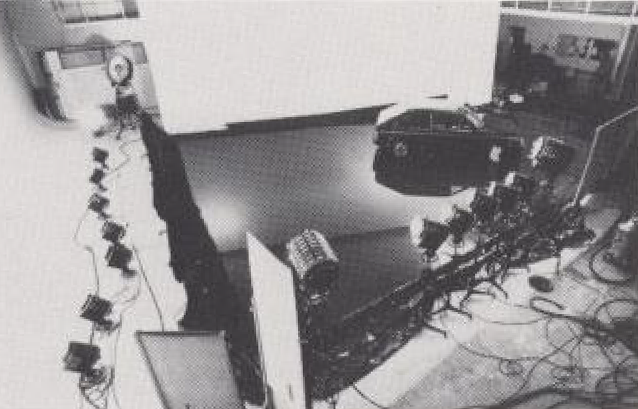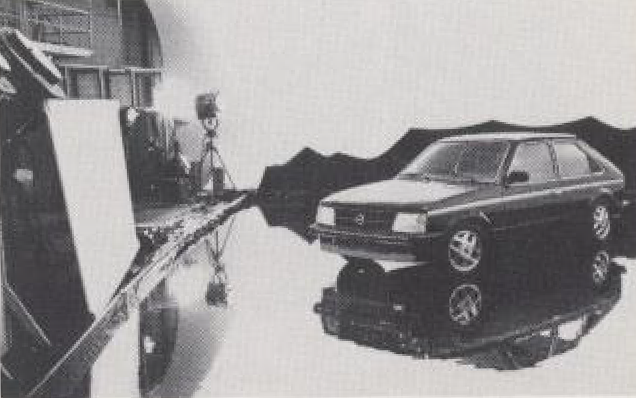Motor car photography
Peter Forster shows his way




For the ultimate image

The photographer

At forty-one, Peter Forster has reached international fame as a specialist motor car photographer. He trained for photography at the Zurich School of Fine Arts and as apprentice in Michael Wolgensingers’s Zurich studio.
After setting up and for 4 years running a photographic studio for an advertising agency, he was employed another 5 years as a photographer. At 31 years, rather late in his own view, Peter Forster set up on his own. He invested in the best equipment and therefore had to ask high fees right from the start. He was successful almost immediately.
After he had been photographing for Volkswagen and Porsche, his round of clients began to include BMW, Mercedes, Fiat and American motor manufacturers. Highlights of recent years were assignments for Toyota and Nissan in Japan. For Forster, this international activity meant recognition and satisfaction. Yet for all this appreciation, the constant travel and work in industrial cities conflicted with his preference for nature and desire to spend more time with his family. So Peter Forster turned a former farm into a sort of refuge – an unusual but successful combination of family, nature and studio. In these surroundings Forster is sure to achieve a lot in fields other than motor photography, too.

The assignment
The advertising agency McCannErikson, Frankfurt approached Forster for the title page illustration for a special Opel model. Needless to say it was needed in a hurry but the agency also wanted a clear quotation before confirming the order. Forster had to work out how to handle the assignment; what materials would be needed, how much time, how much collaboration from the client and the cost. The agency got an immediate quotation by telex: A daily fee of SFr. 2500 plus expenses – not exactly peanuts but Forster’s clients know his top class work and reliable timing which on their side justifies the expenditure, especially in relation to the whole project.



The problem

The layout had to be followed strictly – this was already approved by the client. Because of an embargo the car could only be photographed in the manufacturer’s studio. The scaled layout is an indispensable planning tool, where all datas derive from.
Without this preparation, shooting in a strange studio would have involved too much improvisation and inponderable factors. It was bad enough that the studio had to be painted white despite previous assurances that it was white. Hence the project took three days instead of the planned two.




For the ultimate image

Realisation




Setting up

To achieve the reflection, the car had to be placed in a basin on dark sheeting. The camera position was selected with the 4 x 5 inch SINAR-p and matching 300 mm Apo-Nikkor DB lens and the best position confirmed with Polaroid shots – at first without moving the camera. This fixes the perspective of the shot by the lens’s viewpoint. The best setup Is quickly established with 4 x 5 inch black-and-white Polaroid shots before converting the camera to 8 x 10 inches. The car was then located on blocks and wrapped up to permit painting and installation all round it.
In selecting the viewpoint care was needed over the orientation of the reflecting roof (first surface), front (second surface) and side (third surface).
The basin edge was built up and the basin filled with about 7000 litres of water. The mountain silhouette was built up as a backdrop with tripods and black cloth.



The lighting setup

As the lighting was planned beforehand, the setup could be ambitious: About 15000 watts of yellow light were projected from behind onto the wall above the silhouette so that the reflection In the bottom of the basin was located exactly over the black horizon.
A further 15000 watts were beamed upwards as blue light to generate a blue sky reflection. In-between, about 40 000 watts unfiltered flooded the scene to yield partly neutral reflections on the car.
To provide a black background above the car in the picture, a black screen mask was carefully set up In front of the camera and the position of the mask finalised at the working aperture.
Correct modelling of the bonnet, front and side of the car were assured by graduating the light intensity and appropriate location of white surfaces and black cloths alongside the basin.






The final camera
settings

By switching format changing sets, the SINAR-p was then converted to 8 x 10 inches, a multipurpose standard with universal bellows fitted for the longer extension and the 300 mm lens replaced as a proportional focal length increase by the 600 mm Apo-Ronar. The lens standard remained at the original point to maintain the previously determined viewpoint. The perspective rendering was finalised on the rear standard with the micrometer swings and tilts: In this example a swing about the vertical axis broadened the front of the car. This appears to flatten the shape of the car and so creates the impact envisaged.
A precision tilt of the front standard located the plane of maximum sharpness in the best position; distant and near point focusing now showed that on the 8 x 10 inch image even the extreme points were fully sharp on stopping down the lens between f/32 and f/45.
The bellows hood with hood mask was located in front of the lens to eliminate stray light. This yielded a considerable overall camera length which was no problem in view of the indefinite extendability of the base rail.
For maximum stability the base plate and a second rail clamp were mounted on the SINAR pan-tilt head.

The exposure

Kodak Ektachrome Type B film required an exposure time of 16 seconds which was precisely and reliably timed with the SINAR DIGITAL shutter. The colour rendering was vital. After a test processing run Peter Forster decided to use a 20 R filter, safely located behind the DIGITAL shutter inside the camera.
Apart from the lighting and exposure, innumerable details also needed adjustment on the car itself during the preparations – for instance placing black felt papers behind the hub caps, behind the radiator grille and in the bodywork joints. Unwanted reflections, like from the wing mirror, were toned down with dulling spray. A characteristic fact of the whole operation was that everybody wore protective gloves to avoid the slightest speck of dust in the wrong place.
Peter Forster takes along his SINAR camera outfit and all accessories on every trip, but organises the lighting and other requirements locally. He plans every detail at home at his desk, looking out over the fields, and submits his ideas to his clients by telex. They know that these teletyped suggestions are reliable precursors of another top class picture.


For the ultimate image

The following components of the SINAR system were used for this picture:
- SINAR p 8 X 10 inch Expert,
No. 492.28 - Format changing set,
4 x 5 inches, No. 497.26 - Various rail extensions of 15,
30 and 45 cm, No. 421/23/24.11 - Multipurpose standard No. 437.31
- Universal bellows No. 454.11
- Bellows hood mask No. 533.11
- Filter holder rod No. 472.71
- Bellows holder No. 473.31
- SINAR DIGITAL shutter
No. 522.11 - 600 mm Apo-Ronar NF lens No. 442.21
- 300 mm Apo-Nikkor lens in DB mount, No. 446.81
- Pan-tilt head No. 516.41
- Base plate No. 418.11
- Second rail clamp No. 411.21


SINAR LTD SCHAFFHAUSEN
CH-8245 Feuerthalen, Switzerland Telephone: (053) 5 45 27
Telex: ch 76740
Cables: SINAr CH-8245 Feuerthalen


